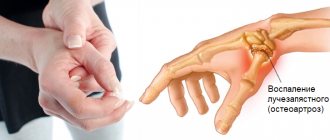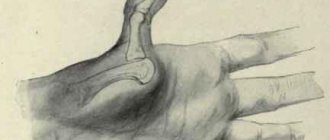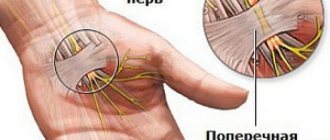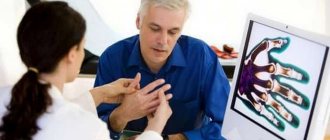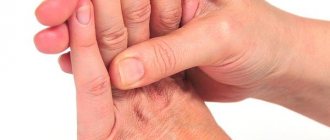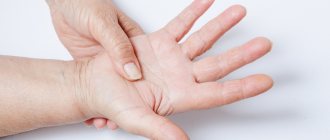Numbness in several fingers
Causes of numbness in fingers
Numbness of several fingers or an entire limb at once can be associated with poor circulation in the cervical spine - this is where the nerve roots responsible for the mobility of the hands and fingers are located. Depending on which vertebrae the infringement occurred between, paresis of the muscles innervated by this root will be observed.
Since osteochondrosis is a systemic disease, several intervertebral discs can be damaged at once, and several nerve roots will be pinched.
With a sedentary lifestyle and sedentary work, a person’s blood circulation in the extremities is impaired . In this case, all fingers, as well as the hand, are affected. Swelling and symptoms of myositis may occur.
The entire hand, along with the fingers, very often goes numb in people who work with a computer mouse for a long time , for example, 8 to 10 hours without a break. Carpal tunnel syndrome may occur , which requires long-term treatment.
Prevention is the crux of the matter
Prevention consists of preventing injuries, overloads and hypothermia of the hand. Regular exercise helps a lot: the better the blood circulation in the small joints, the less likely they are to get sick.
Unfortunately, it is impossible to prevent autoimmune diseases. But the earlier a doctor detects such a disease, the less destruction it manages to cause in the body: such diseases often affect not only the periphery of the body, but also vital organs. Therefore, it is important to pay attention to discomfort in small joints and promptly find out their cause.
Causes of numbness in thumbs
If the thumb on the right hand goes numb , the reasons for this phenomenon may lie in poor nutrition - lack of B vitamins . In some cases, numbness of the limbs accompanies periods when a person practices fasting or diets with limited carbohydrate foods.
If there are disturbances in the digestive system and poor absorption of nutrients, some components may not reach the cells, as a result of which they experience a deficiency of microelements. You should check your intestines and stomach.
Carpal tunnel syndrome
In most cases, the cause of carpal tunnel syndrome is:
- congenital pathologies of the carpal ligament;
- long monotonous movements with the hand, most often the leading one;
- injuries.
Normally, vessels and nerves should pass the carpal canal There is pain in the wrist and numbness in the fingers, including the thumb, which is innervated by a branch of the median nerve.
To avoid this disease, it is recommended to knead your hand daily with a rubber ball or ring if the pathology is associated with monotonous work. In case of other reasons, for example, congenital narrowing of the canal, it is recommended to perform an operation to widen it.
Cubital tunnel syndrome
Compression of the ulnar nerve is the second most common pathology that occurs in people with heavy loads on the elbow joint. It can develop on one or both hands. Sometimes it appears along with carpal tunnel syndrome.
Symptoms of damage to the cubital canal are numbness of the little and ring fingers , tingling, pain, loss of strength in the hand, and inability to hold objects. The dominant hand is most often affected.
The pathology is treated with medications , anti-inflammatory drugs, blockades for severe pain, as well as physiotherapeutic methods - electrophoresis, magnetotherapy, ultrasound with medicinal ointments. If the pain is severe, endoscopic surgery to free the nerve from compression.
After the operation, the patient can return home the same day and undergo rehabilitation at home. After endoscopic surgery, a small suture remains and the likelihood of complications is extremely low.
Anterior scalene syndrome
Between the anterior and middle scalene muscles is the subclavian artery . If it is compressed, the nutrition of the nerve fibers going to the hand is disrupted . If the step muscles are healthy, the nerves are not in danger.
With myofascial syndrome , spasm occurs and the muscle can become very tense. Trigger points of pain arise that cause referred pain in the neck, back and arms. This is the least severe variant of the development of pathology.
The second scenario is more serious: a spasmed muscle causes neurovascular pathology by pinching an artery and limiting blood volume.
Syndrome of the anterior scalene muscle can occur against the background of shortness of breath, arrhythmia , when it takes on the entire burden of providing breaths. Excessive loads in this case can be harmful, causing spasm and inflammation of the tissues.
- The very first symptom of the disease is debilitating pain in the arm and fingers at night , then it moves to the chest and back of the head.
- The second group of symptoms is associated with the appearance of paresis and atrophy of the hand or fingers. This happens in the most advanced cases and is extremely rare.
- The third group of symptoms is associated with impaired lymphatic drainage in the limb and fingers - cyanosis, swelling, disappearance of the pulse when raising the arm up.
- The fourth group is associated with trophic changes in the limb - brittle nails, lack of hair on the hand.
The most serious and dangerous phenomenon is thrombosis of the subclavian artery . A branch arises from it that supplies blood to the brain. If a blood clot forms, an ischemic stroke is possible.
Treatment usually begins with manual therapy, followed by medication and massage, then physical therapy. If conservative methods do not help, it is necessary to perform surgery to excise the muscle itself and nearby tissues to free the artery and nerves.
Radiculopathy
Radiculopathy or radicular syndrome is damage to the spinal nerves due to infection, compression, inflammation or metabolic disorders.
The reason why the thumb on the left or right hand goes numb may be:
- osteochondrosis or protrusion, herniated discs;
- stenosis (narrowing) of the spinal canal;
- damage to the piriformis muscle;
- spondylosis;
- osteoarthritis;
- autoimmune lesions of the nervous system;
- infections;
- hormonal disorders.
Treatment of radiculopathy is complex and requires time and effort, since the problem is to restore the functions of the spine or any system in the body.
Cervical spondylosis
A degenerative disease of the spine, which can result in numbness in the hands and fingers. The disease develops gradually, is more common in older people, but can begin at a young age due to metabolic disorders.
You cannot ignore the symptoms of numbness in the limbs, especially if they are accompanied by neck pain, limited mobility, and heaviness.
It is necessary to treat cervical spondylosis when the first symptoms appear. This is the first stage of the disease, in which there are still no osteophytes, but lesions of the intervertebral discs are already visible.
Rheumatoid arthritis
There are several types of arthritis, an inflammatory disease of the musculoskeletal system. Among them, only rheumatoid is difficult to treat , as it is a disorder of the immune system.
Fingers are very often affected, as there is a greater chance of hypothermia and stress. In women, the disease is more common, since estrogen deficiency plays a major role, especially during menopause.
Valeria
General doctor
Ask a Question
You should pay attention to swelling of the thumb joints. This can be a symptom not only of autoimmune arthritis, but also of gout, when the kidney function to eliminate uric acid salts is impaired.
Amyloidosis
Numbness of the limbs and tingling in the thumb can occur due to amyloidosis. This is a systemic disease caused by the deposition of a special protein substance - amyloid .
Amyloidosis can be congenital or senile, primary or secondary . Sometimes it occurs after blood dialysis.
To determine the disease, it is necessary to conduct a comprehensive examination of the body, take an x-ray of the affected limb, and take blood tests.
Raynaud's syndrome
With Raynaud's syndrome, peripheral circulation is impaired . Most often this occurs due to hypothermia of the hands, with exacerbation of rheumatism, psychopathy, endocrine disorders, constant contact with chemicals, and heavy metal intoxication. There are hereditary cases of the disease.
Symptoms of Raynaud's disease:
- disappearance of pigment on the fingers;
- feeling cold;
- numbness of fingers (including thumb);
- cyanosis of the hands;
- changes or dystrophy of the nail plates;
- gradual curvature of the phalanges of the fingers.
Question to the expert
Why is Raynaud's syndrome dangerous?
The danger of the disease is that at stage 3 the fingers are literally destroyed and a person can become disabled if measures for a cure are not taken in time. Gangrene and blood poisoning may develop.
For treatment, antibiotics, anti-inflammatory drugs, and vasodilators are used to normalize blood circulation. Painkillers are needed to relieve pain In advanced cases, with gangrene , amputation of the fingers or hand is performed, depending on the extent of the spread of pus.
Treatment
First aid
For traumatic injuries, cold and an elevated position of the limb are recommended. The hand is fixed using a splint or available materials (for example, a plank). The hand is raised upward or a scarf is used. In case of intense pain, an analgesic is given; in the absence of external damage, chloroethyl is applied.
Help for diseases is determined by the nature of the pathology - changing the position of the limb, warming or, conversely, cooling can help. The most common measure is rest, however, in some diseases (carpal tunnel syndrome, arthritis), the pain syndrome decreases while maintaining motor activity. Acute jerking pain, pronounced signs of inflammation, general hyperthermia are reasons for urgent consultation with a specialist.
Conservative therapy
For dislocations and fractures, local anesthesia is administered, reduction is performed, and a plaster cast is applied. Conservative treatment of traumatic and non-traumatic finger pathologies involves the following measures:
- Protective mode
. It is selected taking into account the nature and severity of the disease. Recommendations for limiting the load, using orthopedic devices, and applying a plaster cast are possible. - Drug therapy
. Nonsteroidal anti-inflammatory drugs, antibiotics, drugs to improve blood circulation, and neurotropic medications are used. According to indications, blockades with corticosteroids are performed. - Non-drug methods
. Exercise therapy, massage, physiotherapy, manual therapy, and kinesio taping are prescribed.
Surgical interventions
Operations are performed when conservative methods are ineffective, to reduce the time and improve long-term results of treatment. Taking into account the characteristics of the lesion, the following is carried out:
- Injuries
: fixation of fractures and dislocations with knitting needles, necrectomy and amputation of fingers due to frostbite. - Infectious diseases
: opening, drainage of felon, in case of severe lesions in some cases - amputation or disarticulation. - Diseases of tendons and ligaments
: dissection of the dorsal ligament and excision of adhesions for de Quervain’s disease, dissection of the annular ligaments for stenosing ligamentitis. - Neoplasms
: removal of neoplasia, bone resection. - Neurological diseases
: nerve decompression.
After surgery, antibiotic therapy is prescribed. Patients undergo comprehensive rehabilitation aimed at maximizing the restoration of hand function.
Dangerous situations
Sometimes numbness in the thumb is a symptom of a dangerous disease. In such cases, the body will signal with other symptoms. It is important to react in time and go to the hospital to find out the reasons.
Arterial hypertension
Numbness of the limbs is characteristic of stage 2 hypertension , when blood pressure is constantly above normal. Vasospasm constantly progresses without appropriate treatment. Hypertension has an extremely poor prognosis. Without drugs, the disease shortens life expectancy, negatively affecting the kidneys and heart, as well as the brain. If cerebral circulation is impaired, stroke and sudden death .
Diabetes
Diabetic neuropathy is one of the most common symptoms, but they appear first in the legs, then the tingling moves to the arms.
Numbness is a sign of poor circulation. If the skin is wounded and infected, gangrene may develop. For diabetics, this is an extremely undesirable outcome, since the body is weakened by impaired metabolism and takes a long time to recover after surgery.
Avoid overcooling your hands ; you need to maintain blood sugar levels, massage, and move more to stimulate blood circulation.
Lyme disease
Tick-borne borreliosis or Lyme disease is one of the most common infections in the northern hemisphere. Spirochetes are carried by ixodid ticks. The highest activity is in spring and autumn.
A person may not notice the bite, since after sucking blood the tick falls off. The only symptom is ring-shaped migratory erythema on the skin . At the first stage there are headaches and muscle pain, weakness, and symptoms of intoxication.
Peripheral neuropathy with numbness of the limbs and fingers is characteristic of the 2nd chronic stage of the disease, if the body cannot cope with pathogenic microbes on its own.
Heart problems or arthritis may occur . When spirochetes enter the brain, meningitis .
If you suspect a bite (erythema), you need to do a blood test and undergo a course of treatment.
Multiple sclerosis
In multiple sclerosis, entire sections of neurons in the brain are destroyed , so the passage of nerve impulses to parts of the body is disrupted or slowed down. The first sign is deterioration of sensitivity in the hands and fingers. The emotional sphere and the psyche as a whole also suffer.
Valeria
General doctor
Ask a Question
Multiple sclerosis is a systemic disease, and therefore requires complex treatment and constant medication. It is important to accurately establish the cause of the pathology. Often, patients do not immediately consult a doctor, attributing numbness in their fingers to problems with the cervical spine, which often occur during sedentary work.
The effectiveness of therapeutic methods
Therapeutic measures are effective depending on how accurately the diagnosis is made and the cause of numbness in the thumb of the right or left hand is established. Sometimes the symptom can appear symmetrically on both hands, which may indicate a systematic process.
At the initial stage, any pathology is eliminated faster and more effectively . The longer the disease progresses, the more difficult it is to stop it, much less reverse it and achieve recovery.
In advanced cases, radical measures are required - surgery to save the patient's life.

